 Thanks to the wonderful “Rally the Troops” gaming website, I’ve played many, many games of GMT’s Time of Crisis (designed by Wray Farrell and Brad Johnson, art by Rodger MacGowan). It’s rare I get to play a game enough to really explore its full variety of possibilities, but with over sixty games played, I think I can safely say I understand how the game’s mechanics interact with each other and what makes for a set of solid opening moves, designed to allow for a reasonable shot at winning more than the expected 25% of the time.
Thanks to the wonderful “Rally the Troops” gaming website, I’ve played many, many games of GMT’s Time of Crisis (designed by Wray Farrell and Brad Johnson, art by Rodger MacGowan). It’s rare I get to play a game enough to really explore its full variety of possibilities, but with over sixty games played, I think I can safely say I understand how the game’s mechanics interact with each other and what makes for a set of solid opening moves, designed to allow for a reasonable shot at winning more than the expected 25% of the time.
To this end, I have designed my standard three-turn set of opening tactics, which I use as my starting point for each game. Of course, in a 4p game with random events at the start of each turn, that means there could be up to 12 random occurrences before my third turn is over, which means there are many chances for things to go astray, but this set of moves accomplishes two things: (1) if things go optimally, it is the best springboard for a win and (2) it is the most flexible set of moves for when things go less than optimally, allowing for enough flexibility to survive a lot of unpleasant random events. Of course, it’s not perfect. I’ve had games where the gods of randomness just punish me mercilessly and no amount of clever card play can solve that level of bad luck. But if things are just a little bad, or not bad at all, I am usually quite pleased with what I’ve dubbed “The Postumus Opening.”
Gameplay Overview
To step back for a moment, if you do not know the game Time of Crisis, it is a fairly simple, strategic-level wargame where four players vie to reunite a Roman Empire that had shattered in the middle of the 3rd century C.E. (or what we used to call A.D. back when I was a kid, which I think stood for the Age of Donuts), a period of time historians often call “The Third Century Crisis” — hence the game’s title. Each player starts with a hand of 9 lousy cards (all with power 1 and zero bonus abilities), control of one province of the Roman Empire with a governor, 1 general, 1 legion, and 1 militia unit. The goal is to earn 60 points by growing the number of provinces you control, building architectural improvements, and if you can manage it, taking over as Roman Emperor (or as a Pretender to the imperial title with a provincial capital outside of Italy).
Theme aside, what makes this game hum is the fusion of a comparatively streamlined set of possible actions and a Dominion-like deckbuilding system that drives action selection. You start with a deck of 9 cards: 3 Blue, 3 Red, and 3 Yellow, and each color controls a subset of your possible actions. Military actions, like raising troops, moving armies, or fighting battles, use action points generated by your red cards. Taking over new provinces requires the points from blue cards, and improving your popularity and building improvements uses yellow cards. A big part of the game is configuring your deck so that you are always able to select five cards from your deck that let you do the things you need to do on a turn. Yes, I said “select” because one twist over the standard deck building game is that when it comes time to draw five new cards into your hand, you don’t randomly draw cards. Instead, you simply select whichever cards you want—imagine the deck is face up and you can pick and choose. If the cards run out, you grab the discard pile like with a normal deck-builder, but you don’t need to shuffle, just move them from discard to available and choose whichever you want up to 5 cards.
One of the most important actions comes at the end of each turn where your popularity rating across the provinces you control lets you buy new and far more powerful cards (which give more action points but also provide a special bonus). These points can also be spent to destroy (“trash”) your weaker cards so you can avoid a round with low power cards that leave you in the dust as your opponents zoom towards control of the Empire and, more importantly, the 60 points needed to win the game.
Historical Tangent
One final note, before I begin. I named this opening The Postumus Opening after the Roman general, and self-proclaimed Emperor Marcus Cassianius Latinius Postumus, known to history simply as Postumus. Postumus was a legate (general) of some of the legions guarding the Rhine River frontier and when Emperor Valerian was taken prisoner by the Persians (and where he spent the rest of his life as the literal step-stool of the Persian Shah Shapur, one of the best disaster stories of the Third Century Crisis). Upon hearing of Valerian’s capture, Postumus’s troops declared him Emperor, but instead of the usual march directly on Rome, Postumus was content to limit his claim to just what is today Great Britain (Brittania on the game board), Spain & Portugal (Hispania), and France, plus a slice of western Germany (Gallia). To history, this has come to be known as the Gallic Empire. Postumus was eventually killed by his own troops (pretty typical in this Time of Crisis) and his break-away empire was reintegrated into the broader Roman Empire by Aurelian, but for the purposes of our lesson today, we’re just going to focus on Postumus’s rise to control the Gallic Empire – the western chunk of the Roman Empire represented on the Time of Crisis board as Britania, Hispania and Gallia.

From this point on, I am going to assume you understand the rules of the game enough to follow a retelling of how I recommend playing. If you are totally new to the game, it might help to get the game set up on your table or on the Rally The Troops website, or even to play a game with some friends and implement my suggested opening moves as you play. If none of this applies to you and you want to read on, of course, feel free, but apologies in advance; I will not be explaining each rule as I go.
Strategic Planning
Turn 1, Incipit! (It Begins!)
Your first choice will be where to place your initial province, including your free governor, general, and troops. In this example, to mimic Postumus, we’ll choose Gallia. That is my first choice, generally. As a second choice, I might choose Macedonia, or Pannonia, or Hispania, or Asia. What you want is a province that has a few nearby options and you think will leave you with an adjacent empty province on turn 3. But that cannot always be controlled, so pick wherever you can that you think might have some room to grow.
So if you were playing as the Red player, it might look like this after all four players have chosen their provinces:
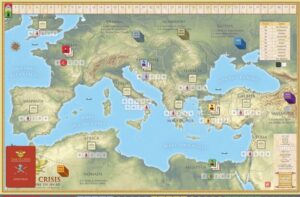
Your second choice will be which 5 of your 9 cards to select. This is the key to the Postumus opening and I think it is the superior choice in general: take 3 blue and 2 yellow cards. Other people may argue for 3 Red, 2 Blue or 3 Blue, 2 Red, but through much testing of each, I can assure you 3 Blue, 2 Yellow is the best. Also, though it oughtn’t need to be said, anything with 3 Yellow is a disaster, as you need to take a 2nd province right away and neither of the 3 Yellow options does that. Also, any option with just 1 yellow is also a disaster, since 1 Yellow point cannot do anything (except in one extremely rare case, which can never happen on turn one). And so there are only 3 viable options (3B+2Y, 3B+2R, or 3R+2B) and I am convinced that 3 Blue plus 2 Yellow is the dominant option.
So here’s my starting hand, along with the 4 cards I did not choose (left “Available” for next turn):
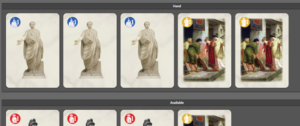
When your turn comes, your move is easy. Use 1 blue point to recruit a new governor. Then use the remaining 2 blue points to place that governor in a territory—using two points will make this an automatic governor placement without the need for a die roll. Ideally, it’s nearby, but that’s not vital for this opening to work.
Since we’re imagining that I’ve started in Gallia, a likely spot for the second province is Britania. It has the disadvantage of being across the sea, so a little harder to get troops there, but this is also an advantage because it’s usually really far away from everyone else if you have Gallia.
Then with your two yellow points, increase the popularity of the spot you just took over so that the governor, who has no troops to guard him, has popularity 2.
Your corner of the map might look like this after your first turn:
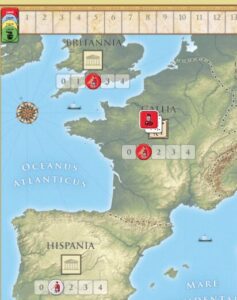
But say you weren’t able to start in Gallia, but instead chose Macedonia. You might place your second governor in Thracia. It might look like this (playing as Red) were to start in Macedonia and claim your second province in Thracia on turn one, with Pannonia as your target for turn three.
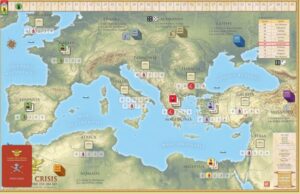
Note that Pannonia is often a better choice than Thracia, but my plan in the example above is to take Thracia on turn 3, knowing that the green player, who goes before me, isn’t going to have red cards available because he opened with a 3 Red + 2 Blue and use the 3 Red to recruit a general, place him in Gallia, and then march him to Hispania. (If it had been me I would have opened with the Exact Postumus rather than this Macedonia variant).
Some might argue that the 2 yellow points are better spent on a Militia unit to guard your second governor. But a province with 1 popularity and 1 Militia unit will fall to a rival governor with 3 blue points (discounting the “exploding 6” rule) whereas an unguarded province with 2 popularity needs 4 blue points for a takeover (also discounting the “exploding 6” rule).
More importantly, though, by using those 2 yellow points to gain popularity, you’ll have 3 points when it comes to drawing cards or trash, which will let you trash a card on turn 1, which is the key to a successful Postumus opening. Use that trash ability to remove one of the two yellow cards you just played, leaving your deck with 3R/3B/2Y.
I think many people would dispute my choice to trash cards on turn 2. They would instead grab a 2 Blue (Tribute or Senatus) or perhaps a 2 Yellow (Ambitus). Or maybe one of the 2 Reds (Cavalry or Castra) just to boost the military, but I am convinced that the cards of 2 value are kind of meh and that streamlining your deck as soon as possible is key. My attitude towards getting Foederati (a 3 Blue) or some of the 4 cards like Demagogue (4Y) or Spiculum (4R) is totally different, but it’s virtually impossible to get those cards until you have 3 or 4 provinces, so until then, focus on trashing your 1s.
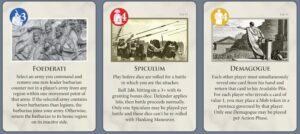
After this first move, you’ll be asked to draw back up to 5 cards. Choose all 4 of the remaining cards (3 red, 1 yellow), and then the 5th card should be the sole remaining yellow, leaving 3 blue in the available pile for the next draw (between turns 2 and 3). You will thus be ready for turn 2 with 3 red and 2 yellow cards.
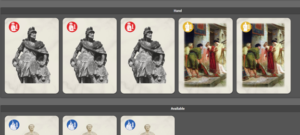
Turn 2, Praeparans Bellum (Preparing for War)
Before you get to execute the second turn of the Postumus Opening, you will have to sit through three other players’ turns (and the random event at the start of your own turn), hoping none of your provinces get invaded by barbarians, that your neighbors focus on their own turf rather than invading yours, and that no other general mischief occurs. If things come around to you and all is well, the next turn is very simple: use your three red points to occupy a neighboring neutral capital and then, if possible, place another troop somewhere. Depending on how it goes, you might have to forgo placing that second troop. Most important is to lock down your Turn 3 province with an occupying force, which prevents anyone else from taking it but also allows you guaranteed success with only 1 blue point used, which is all you’ll be able to afford. One version of what happens might look like this:
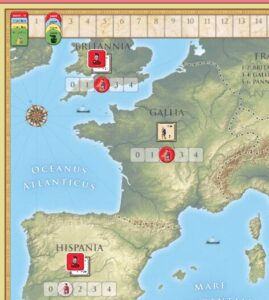
I used 1 red point to move my existing army from Gallia to Hispania and occupy the neutral capital. I have no blue points, so actually taking over will have to wait for the next turn. Then with my remaining 2 red points I recruited a general (1 point) and placed it in Britania (1 point). I could have chosen Gallia, but my thinking was that my existing militia unit in Gallia could guard that against an opportunistic strike from another player, and thus locking down Britannia with troops was more vital.
Then, with the 2 yellow points, I increased Gallia’s popularity to 2, which also serves to prevent an opportunistic attack. It gives me 4 points for the buying/trashing phase, but I will only use 3 of them, and this time I’ll trash a red card, bringing me to a total of 3 Blue, 2 Red, and 2 Yellow. My hand draw will take all 3 of the blue cards left in the “deck” and then 2 yellows, leaving 2 red available for next turn.
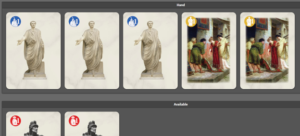
By the way, if you were forced into a variant, such as starting in Macedonia, here’s how things might look after turn 2, with your army in Pannonia ready to take control next turn.
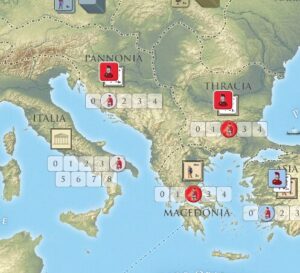
Turn 3: Sociis potitus (Gaining Allies)
If everything works out for turn 3, you are set up for the rest of the game to go swimmingly. Bad things might involve having Barbarians who have invaded your lands or having lost a province to an uppity neighbor. The former concern is quite real. For example, in the game I am using as my example, the Franks just decided to send a 2 unit invasion force in, but fortunately, they chose to invade my rival in Pannonia rather than my exposed province in Gallia.
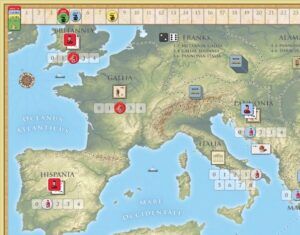
The absence of a Frankish invasion leaves me a free hand to complete the Postumus Opening. I have 3 Blue and 2 Yellow cards in my hand, all 1s. I recruit my 2-point governor for, you guessed it, 2 blue points, and use the third to place him in Hispania. My troops there ensure the election goes without a hitch. And I use the 2 yellow points to boost the new Hispania governor’s popularity to 2 as well, leaving the map like this:
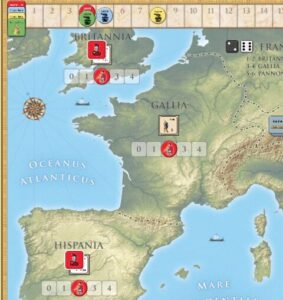
Best of all, I now have 6 points for buying or trashing cards, and I also have 3 provinces, which allows me to start buying level 3 cards at the standard (non-doubled) price. So I buy one of my favorite cards, Foederati (a 3 Blue) and use the other three points to trash one of the basic blue cards I just used. For my card draw, I have to use the 2 reds that were not used this turn, then from the new card, I choose the Foederati card and either the 2 remaining blues or the 2 remaining yellows, depending on the situation. In this example, I’ll go big on blue, with hopes perhaps of claiming the Imperial throne next turn.
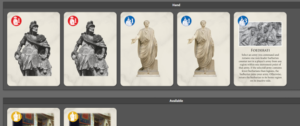
Final Thoughts
From this point onward, you should be earning at least 6 political points (the ones that let you buy or trash cards) every turn, and once you get a 4th province, it’ll be at least 7. That means you can buy a 4-point card every turn and also trash a card, so that in a few more turns, your deck will have no 1s left, and be full of the most useful and valuable cards. Postumus had to content himself with just Hispania, Gallia, and Britannia, but you could dream bigger and capture Rome itself!





















I will have to try this out! I’ve always gone for Macedonia and the 3B/2R opening, but I haven’t had much success.
My next game, I’ll try this one.
I think I’ve been in at least 20 of those 60 games, and I can attest that Andy wins probably 80% of the time (in 4p games!). His system works. I’ll be happy to start copying it.